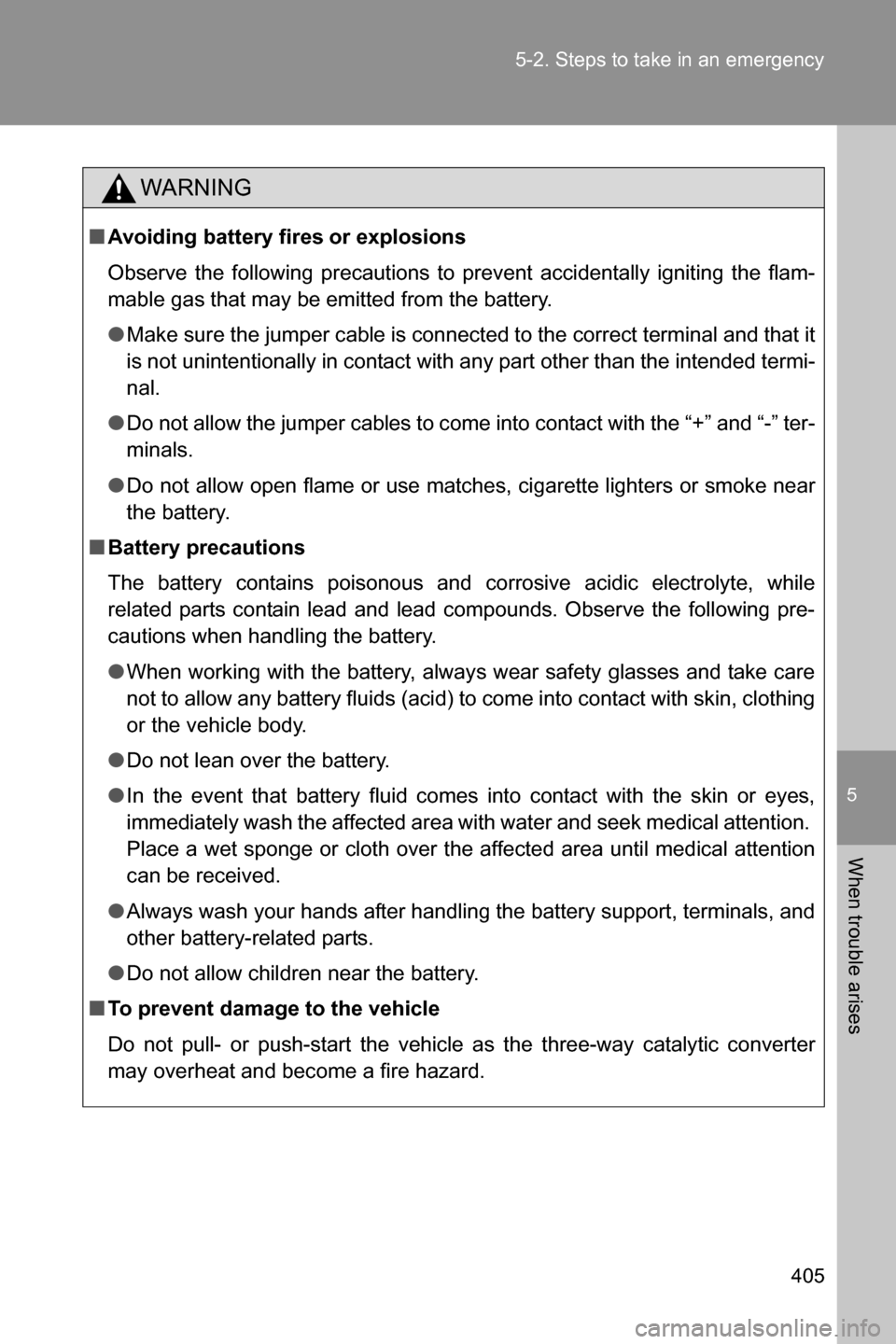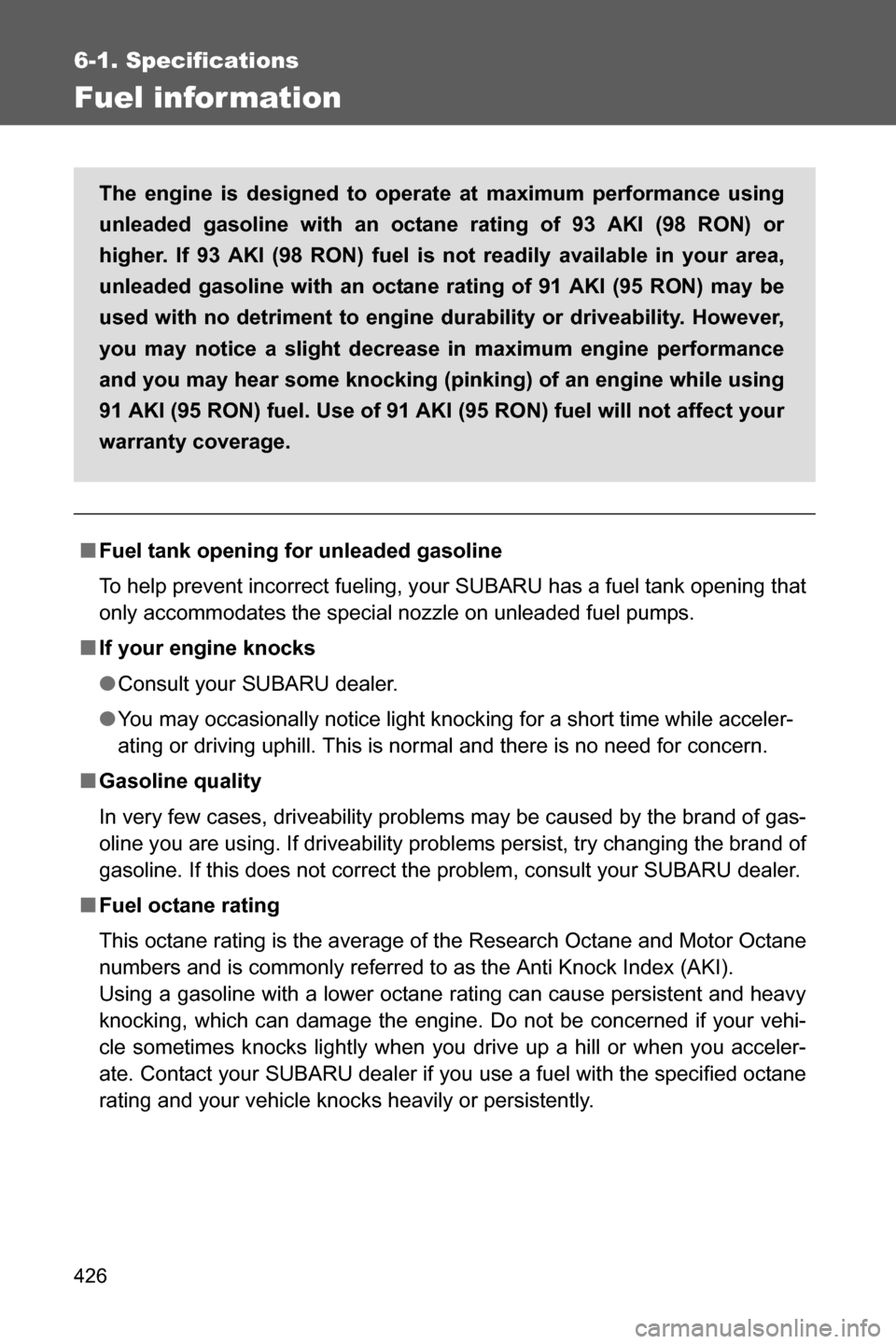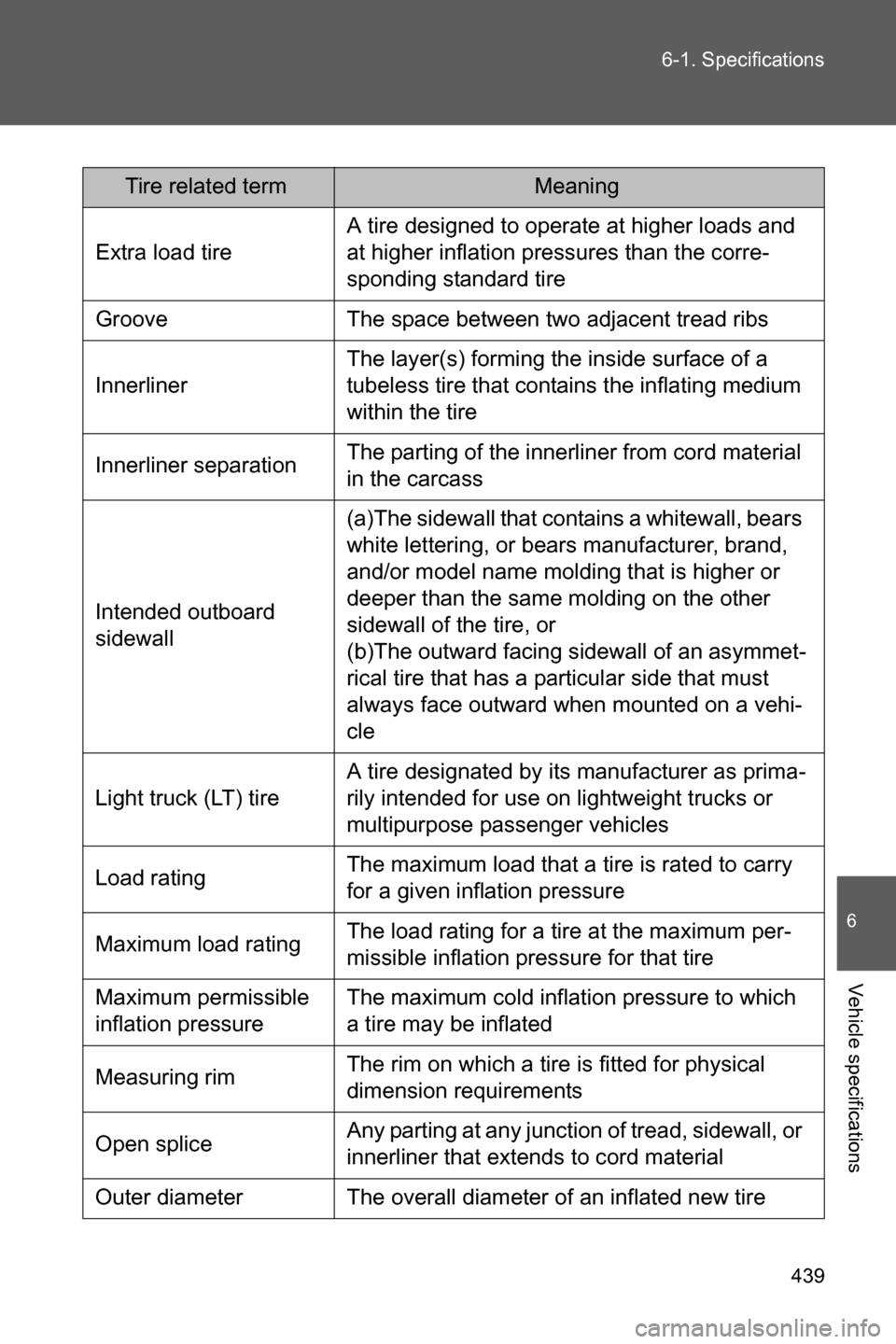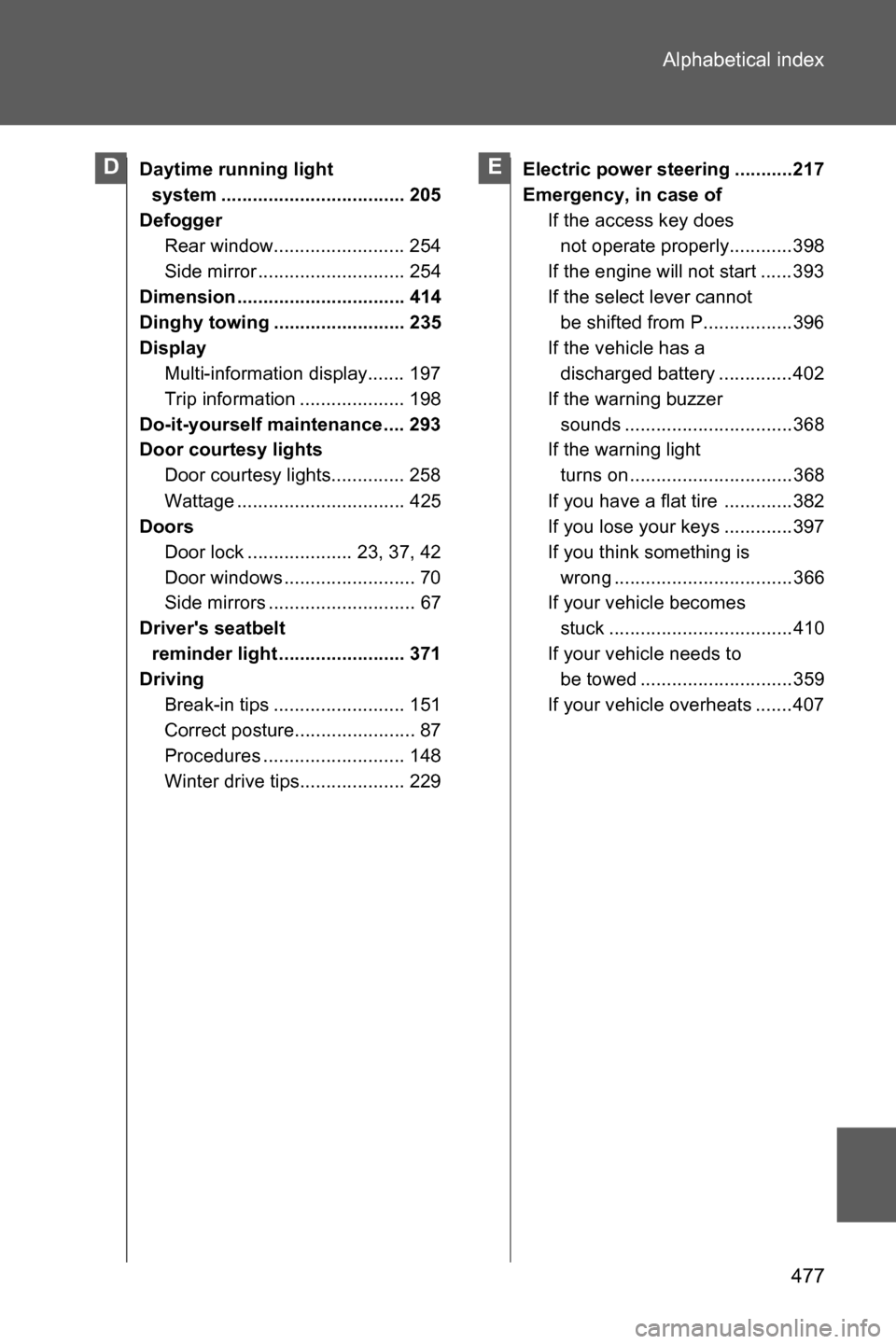Page 406 of 490

5
When trouble arises
405 5-2. Steps to take in an emergency
WARNING
■Avoiding battery fires or explosions
Observe the following precautions to prevent accidentally igniting the flam-
mable gas that may be emitted from the battery.
●Make sure the jumper cable is connected to the correct terminal and that it
is not unintentionally in contact with any part other than the intended termi-
nal.
●Do not allow the jumper cables to come into contact with the “+” and “-” ter-
minals.
●Do not allow open flame or use matches, cigarette lighters or smoke near
the battery.
■Battery precautions
The battery contains poisonous and corrosive acidic electrolyte, while
related parts contain lead and lead compounds. Observe the following pre-
cautions when handling the battery.
●When working with the battery, always wear safety glasses and take care
not to allow any battery fluids (acid) to come into contact with skin, clothing
or the vehicle body.
●Do not lean over the battery.
●In the event that battery fluid comes into contact with the skin or eyes,
immediately wash the affected area with water and seek medical attention.
Place a wet sponge or cloth over the affected area until medical attention
can be received.
●Always wash your hands after handling the battery support, terminals, and
other battery-related parts.
●Do not allow children near the battery.
■To prevent damage to the vehicle
Do not pull- or push-start the vehicle as the three-way catalytic converter
may overheat and become a fire hazard.
Page 426 of 490
425 6-1. Specifications
6
Vehicle specifications
Light bulbs
A: D4S discharge bulbs
B: Wedge base bulbs (amber)
C: Wedge base bulbs (clear)
D: Double end bulbs
Light BulbsBulb No.WTyp e
ExteriorHeadlights
Low/high beamD4S 35 A
Front side marker lights W3.8W 3.8 C
Front turn signal lights WY21W 21 B
Front fog lights PSX24W 24�
License plate lights W5W 5 C
Rear turn signal lights WY21W 21 B
Back-up lights W16W 16 C
Rear side marker lights W5W 5 C
InteriorVanity lights�2D
Trunk light W5W 5 B
Interior light�10 D
Door courtesy lights T10 5 B
Page 427 of 490

426
6-1. Specifications
Fuel infor mation
■Fuel tank opening for unleaded gasoline
To help prevent incorrect fueling, your SUBARU has a fuel tank opening that
only accommodates the special nozzle on unleaded fuel pumps.
■If your engine knocks
●Consult your SUBARU dealer.
●You may occasionally notice light knocking for a short time while acceler-
ating or driving uphill. This is normal and there is no need for concern.
■Gasoline quality
In very few cases, driveability problems may be caused by the brand of gas-
oline you are using. If driveability problems persist, try changing the brand of
gasoline. If this does not correct the problem, consult your SUBARU dealer.
■Fuel octane rating
This octane rating is the average of the Research Octane and Motor Octane
numbers and is commonly referred to as the Anti Knock Index (AKI).
Using a gasoline with a lower octane rating can cause persistent and heavy
knocking, which can damage the engine. Do not be concerned if your vehi-
cle sometimes knocks lightly when you drive up a hill or when you acceler-
ate. Contact your SUBARU dealer if you use a fuel with the specified octane
rating and your vehicle knocks heavily or persistently. The engine is designed to operate at maximum performance using
unleaded gasoline with an octane rating of 93 AKI (98 RON) or
higher. If 93 AKI (98 RON) fuel is not readily available in your area,
unleaded gasoline with an octane rating of 91 AKI (95 RON) may be
used with no detriment to engine durability or driveability. However,
you may notice a slight decrease in maximum engine performance
and you may hear some knocking (pinking) of an engine while using
91 AKI (95 RON) fuel. Use of 91 AKI (95 RON) fuel will not affect your
warranty coverage.
Page 440 of 490

439 6-1. Specifications
6
Vehicle specifications
Tire related termMeaning
Extra load tireA tire designed to operate at higher loads and
at higher inflation pressures than the corre-
sponding standard tire
Groove The space between two adjacent tread ribs
InnerlinerThe layer(s) forming the inside surface of a
tubeless tire that contains the inflating medium
within the tire
Innerliner separationThe parting of the innerliner from cord material
in the carcass
Intended outboard
sidewall(a)The sidewall that contains a whitewall, bears
white lettering, or bears manufacturer, brand,
and/or model name molding that is higher or
deeper than the same molding on the other
sidewall of the tire, or
(b)The outward facing sidewall of an asymmet-
rical tire that has a particular side that must
always face outward when mounted on a vehi-
cle
Light truck (LT) tireA tire designated by its manufacturer as prima-
rily intended for use on lightweight trucks or
multipurpose passenger vehicles
Load ratingThe maximum load that a tire is rated to carry
for a given inflation pressure
Maximum load ratingThe load rating for a tire at the maximum per-
missible inflation pressure for that tire
Maximum permissible
inflation pressureThe maximum cold inflation pressure to which
a tire may be inflated
Measuring rimThe rim on which a tire is fitted for physical
dimension requirements
Open spliceAny parting at any junction of tread, sidewall, or
innerliner that extends to cord material
Outer diameter The overall diameter of an inflated new tire
Page 446 of 490
445 6-2. Customization
6
Vehicle specifications
Automatic
light control
system
(�oP. 202)Light sensor sensitivity ±0% -40% to +40%
Time elapsed before
headlights automati-
cally turn off after doors
are closed30 seconds0 second
60 seconds
90 seconds
Rear window
defogger
(
�oP. 254)Time elapsed before
the rear window defog-
ger turn off (vehicles
with automatic air con-
ditioning system)15 minutes Continue
Illumination
(
�oP. 258)Time elapsed before
lights turn off15 seconds7.5 seconds
30 seconds
Operation when the
doors are unlockedOn Off
Operation after the
engine switch is turned
offOn Off
Interior light illumination
upon approach (vehi-
cles with a keyless
access with push but-
ton start system)On Off
Interior light illumination On Off
ItemFunctionDefault settingCustomized
setting
Page 475 of 490
474
Abbreviation list
Abbreviation/Acronym list
ABBREVIATIONSMEANING
ABS Anti-lock Brake System
ACC Accessory
ALR Automatic Locking Retractor
CRS Child Restraint System
DISP Display
ECU Electronic Control Unit
EDR Event Data Recorder
ELR Emergency Locking Retractor
GAWR Gross Axle Weight Ratings
GVWR Gross Vehicle Weight Rating
I/M Emission inspection and maintenance
LATCH Lower Anchors and Tethers for Children
LED Light Emitting Diode
LSD Limited Slip Differential
M + S Mud and Snow
MMT Methylcyclopentadienyl Manganese Tricarbonyl
MTBE Methyl Tertiary Butyl Ether
OBD On Board Diagnostics
SRS Supplemental Restraint System
TIN Tire Identification Number
TPMS Tire Pressure Monitoring System
TRAC Traction Control
VIN Vehicle Identification Number
VSC Vehicle Stability Control
Page 476 of 490

475
Alphabetical index
Alphabetical index
A/C .................................... 238, 245
ABS........................................... 217
Access key
If the access key does
not operate properly........... 398
Air conditioning filter.............. 326
Air conditioning system
Air conditioning filter ............. 326
Automatic air conditioning
system................................ 245
Manual air conditioning
system................................ 238
Airbags
Airbag operating
conditions................... 104, 112
Airbag precautions for
your child............................ 118
Airbag warning light .............. 369
Curtain airbag
operating conditions........... 112
Curtain airbag
precautions ........................ 118
Front passenger occupant
detection system ................ 124
General airbag
precautions ........................ 118
Locations of airbags ............... 89
Modification and
disposal of airbags ............. 121
Proper driving
posture ......................... 87, 118
Side airbag operating
conditions........................... 112
Side airbag
precautions ........................ 118
Side and curtain airbags
operating conditions........... 112
Side and curtain airbags
precautions ........................ 118
SRS airbags ........................... 89
Alarm .......................................... 83Anti-lock brake system............217
Audio input ...............................256
Audio system
Audio input ............................256
AUX port................................256
iPod .......................................256
Portable music player............256
USB memory .........................256
USB port................................256
Automatic air conditioning
system ....................................245
Automatic light
control system .......................202
Automatic transmission
Automatic transmission .........174
If the select lever cannot be
shifted from P......................396
Manual mode ........................177
Mode select switch ................176
AUX port ...................................256
Back-up lights
Replacing light bulbs .............342
Wattage .................................425
Battery
Checking ...............................306
If the vehicle has a
discharged battery ..............402
Preparing and checking
before winter .......................229
Bottle holders ...........................262
Brake
Fluid ......................................304
Parking brake ........................185
Brake assist..............................217
Break-in tips .............................151
Brightness control
Instrument panel light
control .................................191A
B
Page 478 of 490

477 Alphabetical index
Daytime running light
system ................................... 205
Defogger
Rear window......................... 254
Side mirror ............................ 254
Dimension ................................ 414
Dinghy towing ......................... 235
Display
Multi-information display....... 197
Trip information .................... 198
Do-it-yourself maintenance .... 293
Door courtesy lights
Door courtesy lights.............. 258
Wattage ................................ 425
Doors
Door lock .................... 23, 37, 42
Door windows ......................... 70
Side mirrors ............................ 67
Driver's seatbelt
reminder light ........................ 371
Driving
Break-in tips ......................... 151
Correct posture....................... 87
Procedures ........................... 148
Winter drive tips.................... 229Electric power steering ...........217
Emergency, in case of
If the access key does
not operate properly............398
If the engine will not start ......393
If the select lever cannot
be shifted from P.................396
If the vehicle has a
discharged battery ..............402
If the warning buzzer
sounds ................................368
If the warning light
turns on ...............................368
If you have a flat tire .............382
If you lose your keys .............397
If you think something is
wrong ..................................366
If your vehicle becomes
stuck ...................................410
If your vehicle needs to
be towed .............................359
If your vehicle overheats ....... 407DE